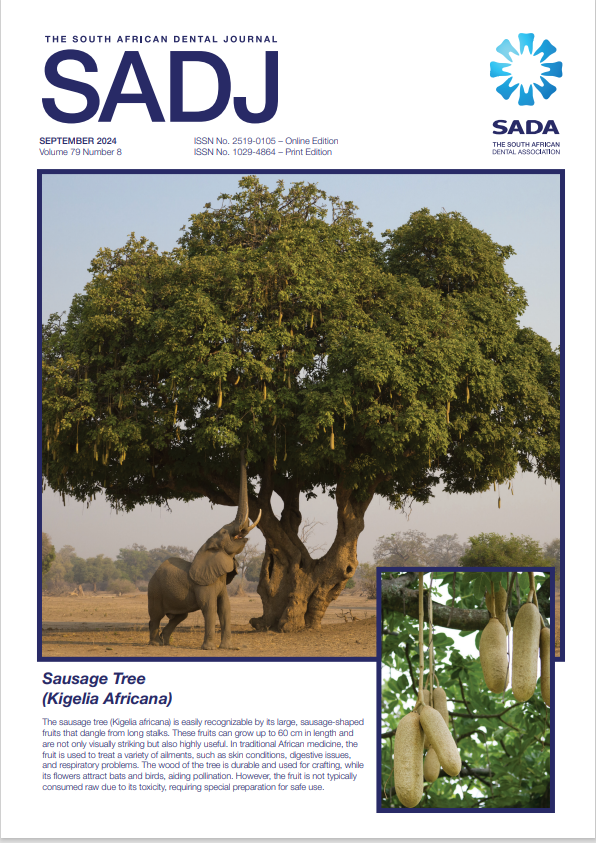Tertiary Treponematosis of the Nasal Cavity – Oral Medicine Case Book
DOI:
https://doi.org/10.17159/Keywords:
Tertiary Syphilis, nasal cavity, treponema pallidum, Immunohistochemistry, Granulomatous inflammationAbstract
Both genital and non-genital treponematoses are overtly similar in pathogenesis, natural history and histologic features. In the head and neck, a relatively small percentage of untreated, infected patients may progress from latency to tertiary disease, with perforation or collapse of the palate and nasal septum. Due to the rarity of tertiary disease and the non-specific histomorphologic features, the disease may go undiagnosed, often with dire consequences. Clinicopathological correlation, a high index of suspicion and a judicious mix of histological and immunohistochemical stains may help the pathologist in arriving at the correct diagnosis. In this article, we report a unique case of nasal treponematosis in a young South African male, discussing the clinical findings, histological features and diagnostic methods of detection.
Downloads
References
1. Giacani L, Lukehart SA. The endemic treponematoses. Clinical Microbiology Reviews 2014; 27(1):89-115
2. Widy-Wirski R. Surveillance and control of resurgent yaws in the African region. Clinical Infectious Diseases 1985; 7(Suppl2):S227-32
3. Taylor WN. Endemic syphilis in a South African coloured community. South African Medical Journal 1954; 28(9):176-8
4. Kanan MW, Abbas M, Girgis HY. Late mutilating bejel in the nomadic Bedouins of Kuwait. Dermatology 1971; 143(5):277-87
5. Prasad BK, Mokamati S. Tertiary nasal syphilis: rare but still a reality. Archives of Otolaryngology & Rhinology. 2016; 2(1):013-5
6. Ficarra G, Carlos R. Syphilis: the renaissance of an old disease with oral implications. Head and Neck Pathology 2009; 3:195-206
7. Shimkin MB. The World Health Organization. Science. 1946 Sep 27;104(2700):281-3
8. Burke JP, Hopkins DR, Hume JC, Perine PL, St John R. International symposium on yaws and other endemic treponematoses, Washington DC, April 16-18, 1984
9. World Health Organization. Four decades of achievement: highlights of the work of WHO. World Health Organization; 1988
10. Anonymous. Yaws again. British Medical Journal 1980; 281:1090-1091. 10.1136/bmj.281.6248.1090
11. World Health Organization. Sexually transmitted infections (STIs). World Health Organization. 2023. Available from: https://www.who.int/news-room/fact-sheets/detail/sexually-transmitted-infections-(stis)
12. French P, Gomberg M, Janier M, Schmidt B, van Voorst Vader P, Young H. IUSTI: 2008 European guidelines on the management of syphilis. International Journal of STD & AIDS 2009; 20(5):300-9
13. Torres Silva MS, Torres TS, Coutinho C, Ismério Moreira R, da Costa Leite I, Cunha M, da Costa Leite PHA, Cáceres CF, Vega-Ramírez H, Konda KA, Guanira J, Valdez Madruga J, Wagner Cardoso S, Benedetti M, Pimenta MC, Hoagland B, Grinsztejn B, Gonçalves Veloso V; ImPrEP Study Group. Bacterial sexually transmitted infections among men who have sex with men and transgender women using oral pre-exposure
prophylaxis in Latin America (ImPrEP): a secondary analysis of a prospective, openlabel, multicentre study. Lancet HIV 2024; 4:S2352-3018(24)00211-X. doi: 10.1016/S2352-3018(24)00211-X
14. Murray JF, Merriweather and Freedman . “Endemic syphilis in the Bakwena Reserve of the Bechuanaland protectorate: a report on mass examination and treatment.” Bulletin of the World Health Organization 1956; 15.6: 975
15. van Niekerk CH, van Niekerk LC, van den Ende J. [Positive serological tests for syphilis in black primary school children in Bloemfontein: a pilot study]. South African Medical Journal 1985; 67: 90-91
16. Zawar V, Chuh A, Gugle A. Oral lesions of syphilis: an isolated, rare manifestation. Dermatology Online Journal 2005; 11(3):46
17. Khan M, Sharma A, Hathorn T, Sandhu M, Rosen R, Riddle N, Mifsud M. The mucosal manifestations of syphilis in the head and neck. Ear, Nose & Throat Journal 2023; Apr 27:01455613231165159
18. Parker NP et al. “The dilemma of midline destructive lesions: a case series and diagnostic review.” American journal of otolaryngology 31.2 (2010): 104-109
19. Montone, Kathleen T. “Differential diagnosis of necrotizing sinonasal lesions.” Archives of Pathology & Laboratory Medicine 139.12 (2015): 1508-1514
20. Buffet M, Grange PA, Gerhardt P, Carlotti A, Calvez V, Bianchi A, Dupin N. Diagnosing Treponema pallidum in secondary syphilis by PCR and immunohistochemistry. Journal of Investigative Dermatology 2007; 127(10):2345-50
21. Papp JR, Park IU, Fakile Y, Pereira L, Pillay A, Bolan GA. CDC laboratory recommendations for syphilis testing, United States, 2024. MMWR Recomm Rep. 2024; 73(1):1-32
22. Chen X. DISSyphilis and the risk of HIV infection: A Mendelian randomization study. AIDS Res Hum Retroviruses 2024; doi: 10.1089/AID.2024.0005. Epub ahead of print. PMID: 39086230
23. Rompalo AM, Joesoef MR, O’Donnell JA, Augenbraun M, Brady W, Radolf JD, Johnson R, Rolfs RT. Syphilis and HIV Study Group. Clinical manifestations of early syphilis by HIV status and gender: results of the syphilis and HIV study. Sexually Transmitted Diseases 2001; 28(3):158-65
24. Liotta LE, Turiansky LG, Berberian BJ, Sulica VI, Tomaszewski CM. Unusual presentation of secondary syphilis in 2 HIV-1 positive patients. CUTIS-NEW YORK2000; 66(5):383-9
25. Glover RA, Piaquadio DJ, Kern S, Cockerell CJ. An unusual presentation of secondary syphilis in a patient with human immunodeficiency virus infection: a case report and review of the literature. Archives of Dermatology 1992; 128(4):530-4
26. Marra CM, Maxwell CL, Smith SL, Lukehart SA, Rompalo AM, Eaton M, Stoner
BP, Augenbraun M, Barker DE, Corbett JJ, Zajackowski M. Cerebrospinal fluid abnormalities in patients with syphilis: association with clinical and laboratory features. The Journal of Infectious Diseases 2004; 189(3):369-76
27. Ghanem KG, Moore RD, Rompalo AM, Erbelding EJ, Zenilman JM, Gebo KA. Lumbar puncture in HIV-infected patients with syphilis and no neurologic symptoms. Clinical Infectious Diseases 2009; 48(6):816-21
28. Workowski KA, Berman SM. Centers for Disease Control and Prevention sexually transmitted disease treatment guidelines. Clinical Infectious Diseases 2011; 53(suppl 3):S59-63
Downloads
Published
Issue
Section
License

This work is licensed under a Creative Commons Attribution-NonCommercial 4.0 International License.





.png)